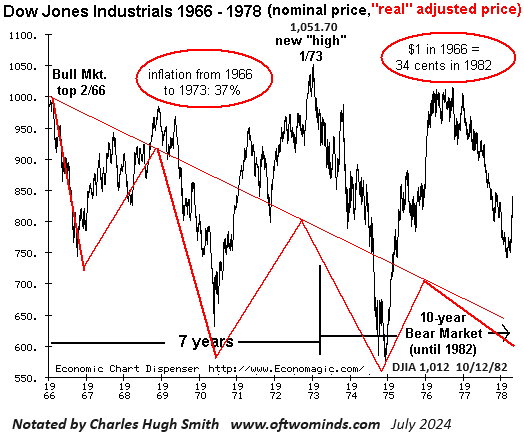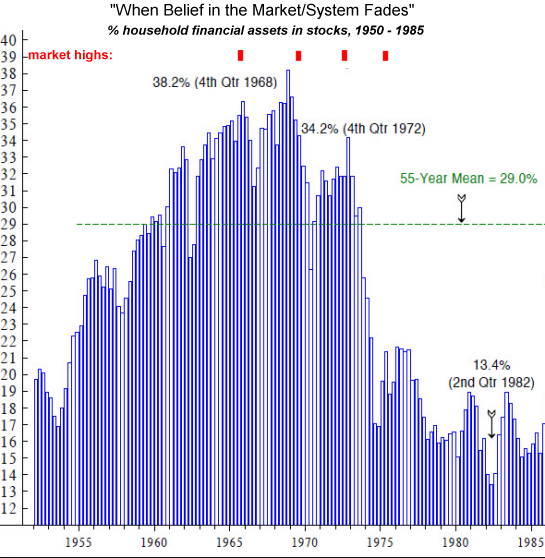Twisters on the Horizon: Is This Decade a Re-Make of 'That 70s Show'?
If we're in a re-make of 'That 70s Show', the plot twists--and twisters heading our way--may be far wilder than we can currently imagine.
I've often written about the 1970s, as it is a profoundly misunderstood decade in so many ways. As one example, the enormous expense of retooling America's industrial base to clean up pollution and become more efficient that I described in
The 1970s: From Rotting Carcasses Floating in the River to Kayak Races (January 22, 2023) added to the stagflationary dynamics of the decade (trillions invested with no immediate increase in productivity or profits) but eventually paid enormous dividends in the decades that followed.
I often discuss cycles, and there are various theories about cycles. One is that all economic cycles share certain traits, for example, an unsustainable expansion of credit that leads to defaults and writedowns (the Kondratieff cycle, the business cycle), or an unsustainable expansion of the money supply.
Another theory holds that we don't repeat the most recent downturn, we repeat the one before that. In this scenario, we'll experience not a repeat of the stagflationary 1970s but the Crash and Depression of the 1930s.
If what we've entered is not just an economic cycle but an era of social-political tumult, then we have to be careful not to assume we can predict which features will echo past cycles. Perhaps we will experience the stagflation of the 1970s in this decade, as financial excesses are worked out and monumental investments to retool our industrial base and infrastructure place a drag on productivity and profits. There is substantial logic in that scenario.
As the charts below illustrate, stagflation also crushed the stock market's speculative dynamic. In the financial realm, That 70s Show was characterized by a massive devaluation of the purchasing power of stocks as a result of elevated inflation and an equally massive decay in the speculative impulse to play the stock market, as the percentage of household assets in the stock market fell from 38% to 14%.
But what we might experience in addition to stagflation is something few seem to recall about the 1970s: the extraordinary unpredictability of events and crises. Consider the situation in April 1973, at the start of President Nixon's second term.
The Christmas Bombing of North Vietnam in December 1972 had brought all parties to the negotiating table again, and a deal bringing closure to the war in Vietnam had been signed. Inflation had flared up, a currency crisis loomed and Nixon had issued sweeping policy changes in August 1971, ending the convertibility of the US dollar to gold in international markets and imposing wage and price controls.
The general outlook in early 1973 was positive, and the Dow Jones Industrial Average (DJIA) topped 1,000 again, reaching a new nominal high. If any seer predicted the Oil Embargo / Gas Crisis that pushed Americans into long lines around gas stations in October 1973, or the kidnaping of media heiress Patty Hearst in February 1974, or the Watergate cover-up leading to Nixon's resignation in August 1974, or the attempt on President Ford's life in September 1975, they are unknown to the world.
If anyone predicted a decade of anti-Establishment domestic terrorism, their prediction is lost to history. The hundreds of bombings of Corporate America buildings, banks and other symbolic fortresses of the Establishment has been ably documented in the book
Days of Rage: America's Radical Underground, the FBI, and the Forgotten Age of Revolutionary Violence.
If anyone predicted that the US dollar would lose two-thirds of its purchasing power from 1966 to December 1981, their prediction is not well known. What $1 bought at the market peak in 1966 cost $3 by December 1981, in the throes of the deepest recession since the Great Depression, a recession triggered by soaring interest rates and monetary tightening to crush the wage-price-spiral inflation that had become embedded in the economy by 1980.
Note that "Dow 1,000" in October 1982 was only "Dow 330" when adjusted for inflation since the peak in 1966-- $1 in February 1966 = $3.07 in October 1982. From the Dow's top in January 1973 at 1051.70 to the point when the Dow reached 1,012 in October 1982, $1 in January 1973 = $2.31 in October 1982. So "Dow 1,000" in January 1973 = "Dow 435" in October 1982.
These data points are from the
CPI Inflation Calculator (BLS.gov).

Few predicted the demise of the belief that "stocks only go up" and the market was a money-making machine available to all gamblers, oops I mean "investors."

If we propose that the 2020s will mirror the 1970s not in the precise dynamics but in the unpredictability of crises and reversals of all that is stable, known and reliable, then we cannot possibly predict what lies ahead. We can only anticipate twisters on the horizon that will be completely unexpected and potentially disruptive on a scale that stretches across culture, society, politics and the economy.
If we're in a re-make of That 70s Show, the plot twists--and twisters heading our way--may be far wilder than we can currently imagine.
My recent books:
Disclosure: As an Amazon Associate I earn from qualifying purchases originated via links to Amazon products on this site.
Self-Reliance in the 21st Century print $18, (Kindle $8.95, audiobook $13.08 (96 pages, 2022) Read the first chapter for free (PDF)
The Asian Heroine Who Seduced Me (Novel) print $10.95, Kindle $6.95 Read an excerpt for free (PDF)
When You Can't Go On: Burnout, Reckoning and Renewal $18 print, $8.95 Kindle ebook; audiobook Read the first section for free (PDF)
Global Crisis, National Renewal: A (Revolutionary) Grand Strategy for the United States (Kindle $9.95, print $24, audiobook) Read Chapter One for free (PDF).
A Hacker's Teleology: Sharing the Wealth of Our Shrinking Planet (Kindle $8.95, print $20, audiobook $17.46) Read the first section for free (PDF).
Will You Be Richer or Poorer?: Profit, Power, and AI in a Traumatized World
(Kindle $5, print $10, audiobook) Read the first section for free (PDF).
The Adventures of the Consulting Philosopher: The Disappearance of Drake (Novel) $4.95 Kindle, $10.95 print); read the first chapters for free (PDF)
Money and Work Unchained $6.95 Kindle, $15 print) Read the first section for free
Become a $3/month patron of my work via patreon.com.
Subscribe to my Substack for free
NOTE: Contributions/subscriptions are acknowledged in the order received. Your name and email remain confidential and will not be given to any other individual, company or agency.
|
Thank you, Troy & C. ($100), for your outrageously generous subscription (and gift!) to this site -- I am greatly honored by your steadfast support and readership. |
Thank you, Li-Chen N. ($3/month), for your magnificently generous subscription to this site -- I am greatly honored by your support and readership. |
|
|
Thank you, Tim G. ($70), for your monumentally generous subscription to this site -- I am greatly honored by your support and readership. |
Thank you, Rick E. ($70), for your superbly generous subscription to this site -- I am greatly honored by your support and readership. |


























